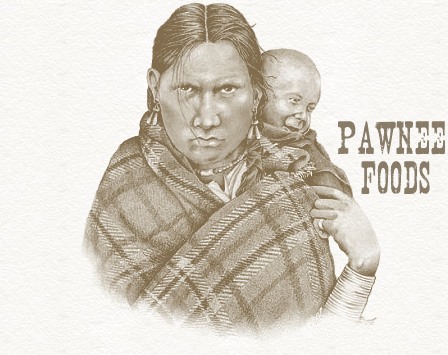The Pawnee were one of the most important Native American tribes of the Plains area. By the late eighteenth and early nineteenth centuries, they were living in circular earthlodges in large villages, sometimes including more than a thousand people. To sustain this number of people, the Pawnee depended not only on hunting, but on gathering and planting as well.
Pawnee women and girls gathered many kinds of food from plants that grew on the prairie. These included milkweed pods, sunflower seeds, wild nuts, and berries. Along streams or in marshy places they found roots of yellow lotus, cattail, wild onions, and sweet flag. They also gathered chokecherries, wild plums, wild grapes, sand cherries, wild potatoes, turnips, and turkey peas.
Cultivated gardens produced much of their food. A Pawnee woman's garden was about one acre in size. They used simple tools: a rake, a hoe made from a bison shoulder blade, and a digger, made from a fire-hardened stick. Using seeds they had saved from the previous year, they planted corn, beans, pumpkins, squash, and melons. Corn, their main food, was picked and roasted or allowed to dry on the stalk before picking. Pumpkins were cut into strips and dried. Corn and beans were dried and put into skin bags and then lowered into an underground storage pit. Some storage pits were located in the earthlodge; others were built outside the earthlodge. The outdoor food pits were ten to twelve feet deep and held food enough for several years.
Small animals, as well as birds and fish, were common sources of food. Wild animals of many types provided the hunter with game. Herds of bison wandered the Plains, and their meat, next to corn, formed the main food for the Pawnee. One bison provided enough meat to feed one person for a year.
Almost every part of the bison was used by the Pawnee. The horns were made into spoons; the thick hide on top of the head was used as a bowl. The heart was used as a sack to carry dried meat and berries. Sometimes the stomach would be filled with water, and then meat, herbs, and wild onions were added. When hot rocks were placed into the mixture, it would boil, so the stomach was sometimes used as a cooking pot.

